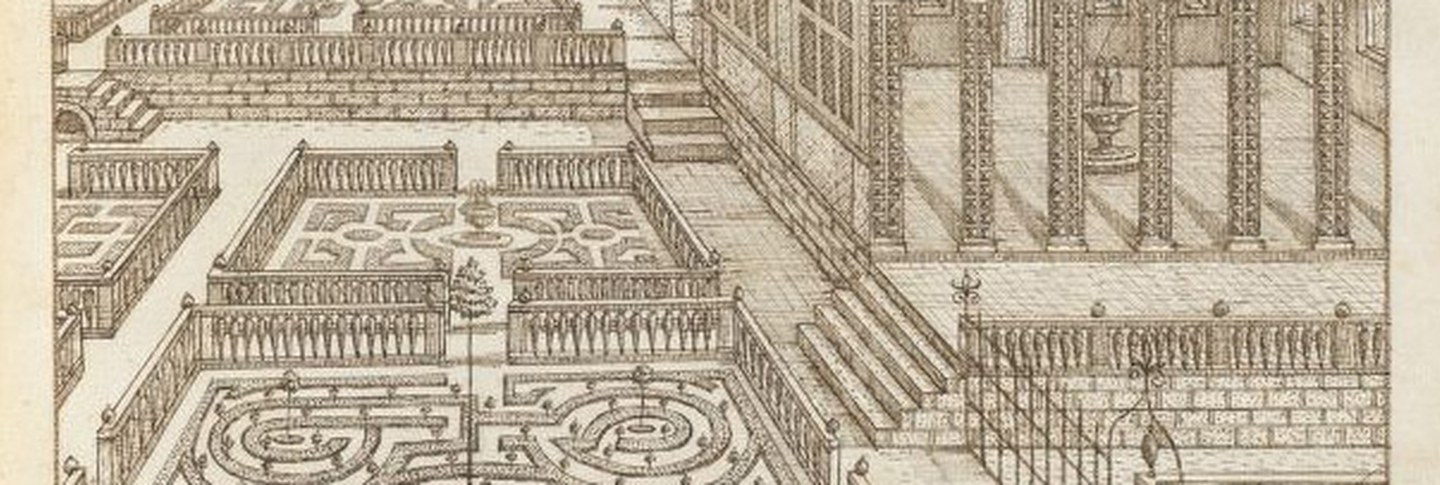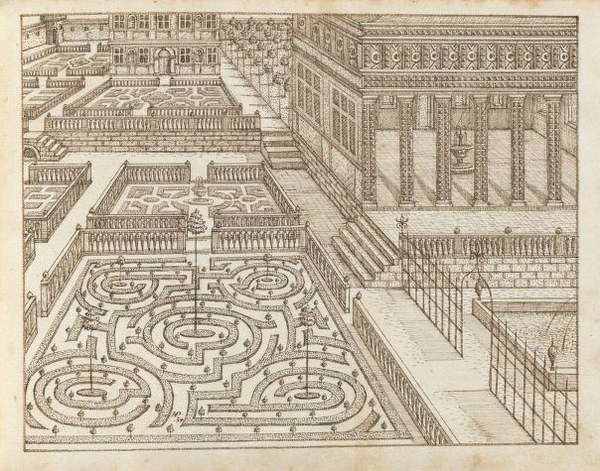As part of an occasional series, we’ll be highlighting individual rare books from the Dumbarton Oaks Rare Book Collection that have been digitized so that anyone, anywhere in the world, can read them at any time through the Harvard University Library Page Delivery Service. You can find a list of all the online rare books from Dumbarton Oaks at this link.
Hans Puechfeldner, Nützliches Khünstbüech der Gartnereij (probably 1593)
At roughly the same time that Shakespeare wrote his plays in the England of Elizabeth I, the court of the Holy Roman Emperor Rudolf II (ruled 1576–1612) in Prague drew a constellation of artists and intellectuals of the highest caliber. Despite Rudolf’s relative haplessness as a politician and ruler, he had exquisite taste and a curious mind: he carved out a home for the astronomers Tycho Brahe and Johannes Kepler, for masters of occult arts, for the great Mannerist painters Bartholomeus Spranger and Giuseppe Arcimboldo. He also amassed an enormous Kunstkammer—a collection of art, curiosities, treasures, and rarities that included amulets, scientific devices, exotic weapons, more than three thousand paintings (including works of Leonardo da Vinci, Titian, Albrecht Dürer, and Hans Holbein the Younger), unicorns’ horns, mandrakes, and many, many books.
Rudolf inherited a library of at least twenty-six hundred volumes, and commissioned more over the course of his thirty-six years on the throne. Many of those books were opulent creations—one-of-a-kind manuscripts full of illustrations and bound with the richest of materials. One of these is a book now in the Dumbarton Oaks Rare Book Collection: the only copy of the Nützliches Khünstbüech der Gartnereij, or “Useful Art-Book of Gardening,” authored and drawn in pen and bistre by Hans Puechfeldner, the emperor’s gardener. (The entire book, scanned at a high quality, can be viewed at this link.)
The book consists principally of hand-drawn plans for garden features of great complexity that wend their way around ornate buildings rendered in fine detail. (There are also three pages of dedicatory text addressed to Rudolf II, and several overhead views of arrangements of trees.) An air of fantasy hovers around Puechfeldner’s wilder imaginings: palaces stretch indefinitely in the background, and lacy patterns of grass and hedge iterate opulently outward, longer than practicality might suggest. To the best of our knowledge, none of the plans were ever realized, and it would require a massive fortune to build the scenes suggested. None of the diagrams are marked with notes that would point in the direction of implementation, such as a fixed scale or suggestions for kinds of trees. The bulk of the drawings are done from a one-point perspective that suggests we are looking over these imaginary gardens from a very tall tower, and shading is minimal and careful, as if the view were from the middle of the day.
Yet the book is titled Nützliches, “useful.” Erik de Jong, former Garden and Landscape Studies Fellow and Senior Fellow (2001–8), has done extensive research on the manuscript and writes that Puechfeldner’s book is best seen as an attempt to draw the practices of the influential Brussels gardener Hans Vredeman de Vries eastward into Central Europe. Indeed, for decades the book’s catalog entry had attributed authorship to Vredeman. But de Jong matched it with two siblings, also by Puechfeldner, in Vienna libraries—thus clarifying the use of “HP” and “Hans Puec” monograms in the drawings, and supported by an entry for “drei garten buchs” by Puechfeldner in the court accounts for 1597. Puechfeldner copies Vredeman in using perspective in his designs; Vredeman in turn had gotten the technique from Italy. De Jong argues that the curious abundance of Puechfeldner’s sketches, which at first “may strike us as superfluous,” makes sense as an attempt to demonstrate proficiency in applying Vredeman’s theories, which are themselves an adaptation of classical architectural theory to garden design. Hence, “nützliches”: the sketches themselves are an application of concept. (De Jong was involved in the restoration of the gardens at the Paleis Het Loo in Apeldoorn, Netherlands, which gives some sense of what Puechfeldner’s ornaments like Puechfeldner’s might look like in practice.)
In addition to the Puechfeldner volume, the Rare Book Collection includes four treatises of Vredeman, the earliest of which dates to 1583. Vredeman’s work also influenced a number of other Northern European garden designers and theorists roughly contemporary with Puechfeldner whose books can be found at Dumbarton Oaks, including the Dutch artist Crispijn de Passe’s 1614 Hortus floridus and German architect Joseph Furttenbach’s 1640 Architectura recreationis.

